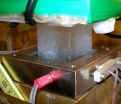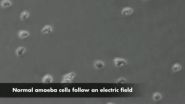Northern ice caused southern rain during last ice age
2015-05-28
(Press-News.org) This news release is available in Japanese.
Armadas of icebergs that broke off the Greenland ice sheet into the northern Atlantic Ocean during the Last Glacial Period -- between about 110,000 and 12,000 years ago -- often increased methane production in the tropics, according to a new study. These findings illustrate how high-latitude events can influence tropical climate conditions, and they hint at the underlying mechanisms of abrupt climate changes. Such massive discharges of icebergs into the Atlantic are known as Heinrich Events, and researchers have wondered for years whether they are the products or causes of climate change. Now, Rachael Rhodes and colleagues have used an ice core from Antarctica to generate a record of methane concentration in the atmosphere that spans from about 67,200 to 9,800 years ago. The researchers found that spikes of methane production in the tropics, which are normally related to increased rainfall in the region, corresponded with four major Heinrich Events. They then used computer simulations to modulate the distribution of rainfall in the tropics at the time. Based on their findings, Rhodes et al. suggest that cold, fresh water, added to the northern Atlantic Ocean by Heinrich Events, could have crippled the Atlantic meridional overturning circulation (AMOC) -- an important kind of ocean circulation related to global climate -- or at least kept it churning slowly. That slowdown, in turn, likely increased precipitation over land in the Southern Hemisphere and caused a boost in methane around the equator, according to the researchers. Although armadas of icebergs might have been able to stay afloat for up to 500 years, the climatic impacts of individual Heinrich Events probably persisted for 740 to 1,520 years, they say.
INFORMATION:
Article #15: "Enhanced tropical methane production in response to iceberg discharge in the North Atlantic," by R.H. Rhodes; E.J. Brook at Oregon State University in Corvallis, OR; J.C.H. Chiang at University of California, Berkeley in Berkeley, CA; T. Blunier at University of Copenhagen in Copenhagen, Denmark; O.J. Maselli; J.R. McConnell at Desert Research Institute in Reno, NV; D. Romanini at Joseph Fourier University in Grenoble, France; D. Romanini at CNRS in Grenoble, France; J.P. Severinghaus at University of California, San Diego in La Jolla, CA; J.P. Severinghaus at Scripps Institution of Oceanography in La Jolla, CA.
ELSE PRESS RELEASES FROM THIS DATE:
2015-05-28
CHICAGO --- HIV has a voracious sweet tooth, which turns out to be its Achilles' heel, reports a new study from Northwestern Medicine and Vanderbilt University.
After the virus invades an activated immune cell, it craves sugar and nutrients from the cell to replicate and fuel its wild growth throughout the body.
Scientists discovered the switch that turns on the immune cell's abundant sugar and nutrient pipeline. Then they blocked the switch with an experimental compound, shutting down the pipeline, and, thereby, starving HIV to death. The virus was unable to replicate ...
2015-05-28
Zoonotic malaria has been shown to be caused by two genetically distinct Plasmodium knowlesi parasite subpopulations associated with different monkey host species in Malaysia, according to new research published in PLOS Pathogens. The authors believe this could have important implications for how the parasite adapts and spreads in humans.
Plasmodium knowlesi is a zoonotic malaria parasite which is common in forest-dwelling macaques. In recent years, increasing numbers of cases of knowlesi malaria have been reported in humans. The disease is now the most common form of ...
2015-05-28
Different people can vary substantially in their genetic susceptibility to viruses, including HIV. Although the biology that underlies this variation in humans is still being uncovered, it seems that we may be able to learn some key lessons from our closest cousins. A gene variant in chimpanzees in a Tanzanian wildlife preserve probably protects them from rapidly succumbing to the primate equivalent of HIV, Stanford University School of Medicine scientists report in the open access journal PLOS Biology, publishing May 28.
The wild chimps inhabit Gombe Stream National ...
2015-05-28
EVANSTON, Ill. --- Can we learn to rid ourselves of our implicit biases regarding race and gender? A new Northwestern University study indicates that sleep may hold an important key to success in such efforts.
Building on prior research, the Northwestern investigators aimed to find out whether learning to alter habitual reactions to other people could be enhanced during sleep.
Other researchers have documented many unsavory consequences of common social biases. When playing a videogame with instructions to shoot only people carrying weapons, players were more likely ...
2015-05-28
CORVALLIS, Ore. - A new study shows how huge influxes of fresh water into the North Atlantic Ocean from icebergs calving off North America during the last ice age had an unexpected effect - they increased the production of methane in the tropical wetlands.
Usually increases in methane levels are linked to warming in the Northern Hemisphere, but scientists who are publishing their findings this week in the journal Science have identified rapid increases in methane during particularly cold intervals.
These findings are important, researchers say, because they identify ...
2015-05-28
TAMPA, Fla. - Advanced non-small cell lung cancer (NSCLC) patients have few effective treatment options and low 5-year survival rates. The checkpoint inhibitors MEDI4736 and tremelimumab have both demonstrated acceptable safety and potential efficacy when used as single-agents in several different types of cancer. Scott J. Antonia, M.D., Ph.D., chair of the Thoracic Oncology Department at Moffitt Cancer Center will be presenting data from a phase 1b dose-escalation and expansion study of MEDI4736 combined with tremelimumab at the 2015 American Society of Clinical Oncology ...
2015-05-28
TAMPA, Fla. - Prostate cancer is the second most common type of cancer in men and is predicted to result in an estimated 220,00 cases in the United States in 2015. In recent years, an emphasis has been placed on chemoprevention - the use of agents to prevent the development or progression of prostate cancer. A team of researchers led by Nagi B. Kumar, Ph.D., R.D., F.A.D.A. at Moffitt Cancer Center recently published results of a randomized trial that assessed the safety and effectiveness of the active components in green tea to prevent prostate cancer development in men ...
2015-05-28
TAMPA, Fla. - Chronic myelomonocytic leukemia (CMML) is a rare type of myelodysplastic, myeloproliferative neoplasm characterized by increased numbers of peripheral monocytes and less than 20 percent blasts. CMML has few treatment options and patients only survive on average for 12 to 24 months. Preclinical studies suggest that JAK2 inhibitors may be an effective treatment option for CMML. Eric Padron, M.D., assistant member of the Malignant Hematology Program at Moffitt Cancer Center will report on the first phase 1 study of the JAK2 inhibitor ruxolitinib in CMML patients ...
2015-05-28
TAMPA, Fla. - The monoclonal antibody nivolumab has shown promise as a therapeutic agent, particularly by improving the survival rates of melanoma patients. Jeffrey S. Weber, M.D., Ph.D., director of the Donald A. Adam Comprehensive Melanoma Research Center at Moffitt Cancer Center will be presenting data from a retrospective analysis of the safety of nivolumab in 4 ongoing phase I-III studies in melanoma patients at the 2015 American Society of Clinical Oncology Annual Meeting in Chicago.
Nivolumab targets a protein called the programmed death-1 (PD-1) receptor. The ...
2015-05-28
Many living things can respond to electric fields, either moving or using them to detect prey or enemies. Weak electric fields may be important growth and development, and in wound healing: it's known that one of the signals that guides cells into a wound to repair it is a disturbance in the normal electric field between tissues. This ability to move in response to an electric field is called galvanotaxis or electrotaxis.
UC Davis dermatology professor Min Zhao, Peter Devroetes at Johns Hopkins University and colleagues hope to unravel how these responses work, studying ...
LAST 30 PRESS RELEASES:
[Press-News.org] Northern ice caused southern rain during last ice age

